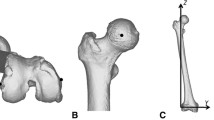Abstract
Age- or sex-related differences in femoral curvature affect the onset of trauma or degenerative diseases of the hip joints. This study aimed to investigate femoral curvature in detail in Japanese individuals using three-dimensional computed tomography, evaluate its effects on the position of proximal femur, and assess differences in femoral curvature according to age and sex. We measured sagittal and coronal femoral bowing in 40 elderly (mean age 85.2 years) and 40 adult (mean age 30.1 years) Japanese individuals using computed tomography. In adult individuals, the radii of the femoral curvatures of the distal end and shaft in the coronal planes were significantly smaller in women than in men. In contrast, no significant difference was observed in femoral curvature between the sexes in the elderly group. Furthermore, the radius of femoral curvature was significantly smaller in elderly individuals than in adult individuals, regardless of the sex and location of the measurement. The highest point of the greater trochanter of the femoral head center was 7.3 ± 5.6 mm in the elderly group and 2.2 ± 4.6 mm in the adult group (p < 0.05). Thus, the femoral curvature varies with age and sex in Japanese individuals. In addition, the femoral curvature could cause positional changes in the proximal femur, such as the highest point of the greater trochanter. Therefore, further studies investigating the biomechanical effects of these morphological changes are warranted.







Similar content being viewed by others
References
Abdelaal AH, Yamamoto N, Hayashi K et al (2016) Radiological assessment of the femoral bowing in Japanese population. SICOT J 2:2
Anderson JY, Trinkaus E (1998) Patterns of sexual, bilateral and interpopulational variation in human femoral neck-shaft angles. J Anat 192:279–285
Ballard ME, Trudell MB (1999) Anterior femoral curvature revisited: race assessment from the femur. J Forensic Sci 44:700–707
Beck TJ, Ruff CB, Scott WW, Plato CC, Tobin JD, Quan CA (1992) Sex differences in geometry of the femoral neck with aging: a structural analysis of bone mineral data. Calcif Tissue Int 50:24–29
Egol KA, Chang EY, Cvitkovic J, Kummer FJ, Koval KJ (2004) Mismatch of current intramedullary nails with the anterior bow of the femur. J Orthop Trauma 18:410–415
Hagino H, Katagiri H, Okano T, Yamamoto K, Teshima R (2005) Increasing incidence of hip fracture in Tottori Prefecture, Japan: trend from 1986 to 2001. Osteoporos Int 16:1963–1968
Harma A, Germen B, Karakas HM, Elmali N, Inan M (2005) The comparison of femoral curves and curves of contemporary intramedullary nails. SurgRadiolAnat 27:502–506
Harper MC, Carson WL (1987) Curvature of the femur and the proximal entry point for an intramedullary rod. ClinOrthopRelat Res 220:155–161
Jingushi S, Ohfuji S, Sofue M et al (2011) Osteoarthritis hip joints in Japan: involvement of acetabular dysplasia. J Orthop Sci 16:156–164
Maehara T, Kiyono M, Noda T et al (2019) The morphology of the femur in elderly Japanese females: analysis using 3D-CT. J OrthopSurg 27:2309499018816488
Maratt J, Schilling PL, Dougherty R, Murphy R, Wang SC, Goulet JA (2014) Variation in the femoral bow: a novel high-throughput analysis of 3922 femurs on cross-sectional imaging. J Orthop Trauma 28:6–9
Matsumoto T, Hashimura M, Takayama K et al (2015) A radiographic analysis of alignment of the lower extremities—initiation and progression of varus-type knee osteoarthritis. OsteoarthrCartil 23:217–223
Oh Y, Wakabayashi Y, Kurosa Y, Fujita K, Okawa A (2014) Potential pathogenic mechanism for stress fractures of the bowed femoral shaft in the elderly: mechanical analysis by the CT-based finite element method. Injury 45:1764–1771
Ruff C (1987) Sexual dimorphism in human lower limb bone structure: relationship to subsistence strategy and sexual division of labor. J Hum Evol 16:391–416
Ruff CB, Hayes WC (1988) Sex differences in age-related remodeling of the femur and tibia. J Orthop Res 6:886–896
Stewart TD (1962) Anterior femoral curvature: its utility for race identification. Hum Biol 34:49–62
Tang WM, Chiu KY, Kwan MFY, Ng TP, Yau WP (2005) Sagittal bowing of the distal femur in Chinese patients who require total knee arthroplasty. J Orthop Res 23:41–45
Tsunenari T, Tsutsumi M, Ohno K et al (1993) Age- and gender-related changes in body composition in Japanese subjects. J Bone Miner Res 8:397–402
Yanai M, Kon A, Kumasaka K, Kawano K (1997) Body mass index variations by age and sex, and prevalence of overweight in Japanese adults. Int J ObesRelatMetabDisord 21:484–488
Zuber K, Schneider E, Eulenberger J, Perren SM (1988) Form and dimension of the bone marrow cavity of the human femur with reference to the fit of intramedullary implants. Unfallchirurg (Trauma Surg) 91:314–319 ((in German))
Acknowledgements
The authors would like to thank Editage (http://www.editage.com) for English language editing.
Funding
None.
Author information
Authors and Affiliations
Contributions
Study conception and design: HT and TS. Material preparation, data collection, and analysis: HT and NK. Manuscript (first draft): HT and NK. Manuscript revision and approval of final manuscript: all authors.
Corresponding author
Ethics declarations
Conflict of interest
The authors declare that they have no conflict of interest.
Additional information
Publisher's Note
Springer Nature remains neutral with regard to jurisdictional claims in published maps and institutional affiliations.
Rights and permissions
About this article
Cite this article
Tagomori, H., Kaku, N., Shimada, T. et al. Effect of age and sex on femoral curvature in the Japanese population: three-dimensional computed tomography findings. Anat Sci Int 96, 411–421 (2021). https://doi.org/10.1007/s12565-021-00606-x
Received:
Accepted:
Published:
Issue Date:
DOI: https://doi.org/10.1007/s12565-021-00606-x




